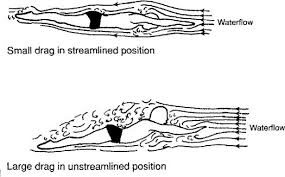I remember the first time I tried swimming for exercise. It was after a marathon, and I was looking for active recovery that would offer little impact on my sore body.
Swimming seemed reasonable enough.
After only four laps in the pool, I began to seriously doubt whether I was in shape. How could that be? I just finished running a Boston-qualifying marathon time. How is it possible that I’m not in shape?
Sure, I didn’t have swim-specific fitness; however, my main problem was that I was swimming very inefficiently, thus increasing my drag in the water, and increasing the amount of effort it took to schlep my body from one end of the pool to the other.
It doesn’t take too long to figure out that swimming is a very technique-reliant sport. You will not get much faster by simply swimming from end to end. So, what’s the trick to improved efficiency?
Drills.
Whether you are an elite swimmer, or hopping in the pool for the first time, drills should comprise some part of every swim workout.

For beginners, the most important drills to focus on are breathing and balance-related. When we bike or run, we have several points of contact to assist ourselves in achieving a bio-mechanically efficient position. In the water, we have none. Therefore, we have to improve our balance to ensure that our body position is as level with the water as possible, so as to reduce drag.
The most common problem for beginners is that the lower body drops in the water. Ideally, you want to swim parallel to the water. You can see the difference in the images to the right.
So, how can you achieve this straight line in your swimming? Balance drills. Here we offer a basic overview of two types of balance drills–front and side–with modifications you can add as you improve.
Front Balance Drills
The key to this drill is keeping your head and neck even with your spine, and avoiding the temptation to hold your head up, or to look up. As soon as you look up, or even tilt your head upwards, your legs and hips will drop.
Begin the drill by floating face down, with your face in the water. Extend your arms straight out in front of you, parallel with the water surface, for improved balance. Keep your palms facing down toward the bottom of the pool. Look downward.
Begin kicking, keeping your arms extended in front of you. When you raise your head to breathe, you will notice that your legs will immediately drop. Return to the original position, and your legs and hips will rise to the water surface again. To avoid bringing your head out of the water to breathe, you can use a swimmer’s snorkel for this drill. If you have a very hard time balancing, you can use fins in the beginning. However, avoid becoming reliant on the fins.
Once you master this drill, you can then try it with your arms at your sides. This will require more balance control. So, don’t move on until you are ready.
Here’s a video demonstrating how it looks:
Side Balance Drills
As you improve your front balance, you can begin to work on your side balance, which will teach efficient body rotation for the freestyle stroke.
For this drill you will kick while balancing on one side. The trick with this drill is to keep from rolling either on to your back, or your front.
Start by lying on your left side, with your left arm extended in front of you and your right arm laying at your side. Your right hand can rest on your hip/leg. Press your head toward your extended arm, and face upwards (allowing you to breath). Keep the left side of your chest pressing into the water, similar to the front balance drill. Start kicking. When you complete one length, switch to the right side of your body, and repeat.
As with the front balance drill, you can use fins to help you learn the feel. However, do not become reliant on the fins.
Here’s a demo of the drill with the swimmer’s face in the water (except to breathe):
As you master this drill, you can try it with your face in the water or with both arms at your sides. You can also rotate from side to side, by kicking 6 beats on one side, take one stroke to switch to the other side, kick 6 beats, and then rotate back to the other side for 6 beats. Repeat for the length of the pool. Here’s a demo of this drill, which can also be helpful for learning bilateral breathing:
Swimming is a technique-reliant sport. Learning proper balance and body position is the most important skill to learn when you are just starting. Introduce these drills into your next swim session, and after a few sessions you should begin to notice a difference in the way your body moves through the water.
